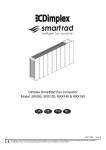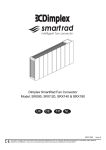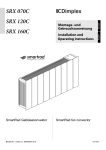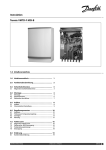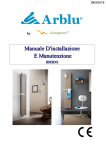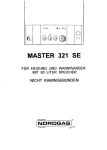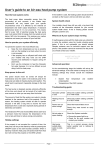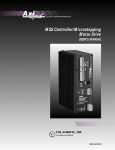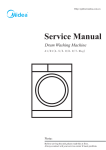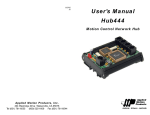Download Dimplex SRX80 Technical data
Transcript
Dimplex SmartRad Fan Convector SRX 080M, SRX 120M, SRX 140M & SRX 180M EN DE srx_en-de_ba 12/10/A The product complies with the European Safety Standards EN60335-1 and the European Standard Electromagnetic Compatibility (EMC) EN55014, EN60555-2 and EN60555-3. These cover the essential requirements of EEC Directives 2006/95/EC and 2004/108/EC (b) 4 100 MIN (c) 150 MIN 1 535 (a) 150 MIN (d) 235 MIN 82 125 MIN 100 590 MIN 180 362 2 38 30 A B C D SRX 080 503 324 396 386 SRX 120 670 492 564 564 SRX 140 740 562 634 624 SRX 180 911 732 804 794 3 K D C B A J 15 50 50 150 220 H G F E 5 6 L1 N P L1 N P 7 Power Output 3 SRX180 2 1 3 SRX140 2 1 3 SRX120 2 1 3 SRX80 2 1 35°C 1631 1079 641 1299 838 493 1120 719 415 759 479 251 45°C 2734 1803 1069 2177 1403 823 1878 1201 693 1273 801 419 Q = 450 l/h 55°C 3844 2530 1499 3061 1968 1154 2641 1686 971 1790 1124 588 65°C 4959 3260 1929 3951 2536 1484 3408 2172 1249 2050 1448 756 3 SRX180 2 1 3 SRX140 2 1 3 SRX120 2 1 3 SRX80 2 1 35°C 1480 1020 625 1199 802 484 1044 691 408 719 465 249 45°C 2502 1713 1044 2024 1346 808 1760 1160 683 1210 780 416 Q = 300 l/h 55°C 3520 2406 1464 2850 1892 1133 2479 1629 957 1705 1095 582 65°C 4546 3102 1885 3682 2439 1459 3202 2100 1231 2203 1412 749 3 SRX180 2 1 3 SRX140 2 1 3 SRX120 2 1 3 SRX80 2 1 35°C 1059 820 558 900 671 442 806 591 379 587 413 237 45°C 1832 1408 948 1558 1151 749 1394 1010 641 1012 704 399 Q = 150 l/h 55°C 2648 2021 1346 2256 1651 1063 2016 1447 907 1460 1005 564 65°C 3498 2655 1750 2984 2167 1378 2668 1894 1174 1926 1309 728 3 SRX180 2 1 3 SRX140 2 1 3 SRX120 2 1 3 SRX80 2 1 35°C 852 695 506 752 591 411 689 530 357 530 387 231 45°C 1431 1167 848 1269 995 691 1164 894 599 902 655 387 Q = 100 l/h 55°C 2020 1647 1175 1798 1355 955 1557 1215 828 1190 884 534 65°C 2559 2109 1542 2263 1793 1251 2070 1606 1083 1580 1163 694 3 SRX180 2 1 3 SRX140 2 1 3 SRX120 2 1 3 SRX80 2 1 35°C 551 487 394 511 436 338 480 402 302 392 312 207 45°C 918 812 657 852 728 564 802 672 504 655 522 345 Q = 50 l/h 55°C 1284 1136 920 1193 1020 791 1124 943 707 921 734 486 65°C 1649 1460 1183 1535 1313 1019 1446 1215 912 1191 950 627 55/47°C 3925 2424 1395 2982 1828 1039 2506 1541 856 1595 956 516 65/50°C 4628 2879 1636 3492 2154 1176 2924 1770 1017 1777 1137 607 3 SRX180 2 1 3 SRX140 2 1 3 SRX120 2 1 3 SRX80 2 1 Q 35/30°C 1495 893 522 1078 631 344 870 561 331 573 358 201 45/40°C 2856 1760 1008 2172 1329 752 1826 1119 621 1165 695 375 -1Dimplex SmartRad fan convector EN Models: SRX 80, SRX 120, SRX 140 & SRX 180 PLEASE STORE THESE INSTRUCTIONS IN A SAFE PLACE. Technical data Important safety information The air inlet and outlet guards must not be covered or blocked. Before performing maintenance work on the device, disconnect it from the power supply. THE DEVICE MUST BE GROUNDED. The heater must not be installed directly below a permanently installed socket. Combustible materials or liquids and other highly flammable furnishings must be kept away from the heater. For the necessary minimum distances (in mm), see fig. 4. Install the device such that it is not possible for someone in the bath or shower to touch the control elements. The heater must not be operated in very dusty areas. This device is not suitable for children or persons who cannot use the device safely as a result of physical or mental disability or reduced perception without the assistance or supervision of another person. Children should be supervised to ensure they do not play with the device. A warning symbol is attached to the heater. This indicates that the device must not be covered. The operating instructions belong to the device and must be stored in a safe place. If the owner changes, the operating instructions should be passed on to the new owner. IMPORTANT – If the mains cable of the device is damaged, it must be replaced by the manufacturer, a customer service representative or a similarly qualified person. Always ensure proper operation. Device description The SmartRad model is a fan convector for heating living spaces. The fan convector is intended for connection to a central heating system. The fan convector is suitable for use in heat pump systems, but it can also be operated in conjunction with other heating systems, e.g. with oil or gas fires. The device draws in air from the underside. This is heated up in the heat exchanger and discharged at the top. Fig. 1: (a) Casing cover (b) Control panel (c) Air outlet guard (d) 1 m connection cable Fan convectors may only be used in central heating systems with a closed control circuit. The heating system must be operated as a dual-pipe system. The devices must be of a sufficient rating such that they can compensate for heat losses in the room. Heat output (kW) at flow temperature of 45°C Temperature range of flow temperature (°C) Maximum permissible flow temperature (°C) Permissible operating overpressure (MPa) Pressure drop (kPa) Air volume flow (m³/h) Sound pressure level at 1 m (dB(A)) 2 SRX 80 SRX 120 SRX 140 SRX 180 0.70 1.10 1.40 1.80 25 – 85 85 1 3 2 1 3 2 1 11.3 228 125 60 Nominal voltage Power consumption of fan (W) 3 2 1 Standby energy consumption (W) Protection category Volume of heat exchanger (ml) Dimensions W x H x D (mm) Weight (kg) 26 19 16 13.1 345 190 100 13.7 410 225 120 47 38 27 ~ 230 V, 50 Hz 43 56 29 36 20 24 15.8 540 300 160 50 33 23 <1 IP 20 310 430 480 600 503 x 530 x 145 12 670 x 530 x 145 15 740 x 530 x 145 17.5 911 x 530 x 145 22 Installation preparation Remove packaging material. Unscrew the four fixing screws from underside of device (see fig. 2) to remove casing cover. Store casing cover such that it cannot be damaged during installation. Fixing to the wall For drywalls, use suitable fixing material (not supplied)! Draw and drill four holes on a sturdy wall as shown in fig. 4. All dimensions are in mm. Insert dowels and pre-fit the two top screws (don't completely screw in yet). Hang device on the two top screws. Insert and tighten the two bottom screws, then tighten the two top screws. Hydraulic connection To ensure a sufficient heating water flow rate through the fan convectors, observe the following points: - The devices are not suitable for installation in single-pipe systems. - The nominal width of the connection pipe must have a minimum diameter of 15 mm. - If the devices are installed in a heating system with various heat distribution systems (e.g. underfloor heating), a separate circuit is required to guarantee a sufficient water flow rate. - For optimum operation (heat output) of the fan convectors, -2a hydraulic balance is required on the heating system. Fig. 5 shows the various hydraulic connection options on the device. The recommended flow and return connections are shown in fig. 5 and fig. 4 (below). The heating pipes can be laid in the floor or in the wall. The device is supplied with two copper pipes with a diameter of 15 mm that are fitted on the heat exchanger at the factory. Before and during filling of the heating system, all pipe connections must be checked for leaks. During filling, the bleeder valve (see fig. 4) must be open such that air can escape from the device. If necessary, bleed again following commissioning (circulating pump running). Electrical connection WARNING: The device must be grounded. WARNING – phase conductor (brown) and neutral conductor (blue) must not be swapped as this may cause malfunctions. The electrical connection should have a supply voltage of ~230240V, 50 Hz. The device must be installed by a qualified electrician in compliance with the existing standards and local installation guidelines. Before performing installation, ensure that the power supply is switched off. The device is equipped with a flexible 1 m connection cable (4 x 0.75 mm²), which can be used to connect the heater directly to the power supply via a suitable wall socket. In the electrical supply line, fit a circuit breaker for each pole with a contact opening width of at least 3 mm. Automatic fuses are also permitted as separators. Automatic fuses should have a delayed tripping characteristic. Conductor configuration of the connection cable: Brown: 'L' – supply voltage phase conductor Blue: 'N' – supply voltage neutral conductor Green/yellow: 'PE' grounding conductor Black: control conductor (temperature reduction; on/off) For circuit diagram, see fig. 6. Control conductor The black control conductor has the following functions: Lowering temperature using an external timer or switch By activating the control conductor, see fig. 6 on the left, the set target temperature on the device is lowered. The temperature reduction is forwarded to any downstream devices via the control conductor. Operation with programming cassette The control signals of the programming cassette, which is plugged into the pilot device, are forwarded to any downstream devices via the control conductor, see fig. 6 on the right. The control conductor does not have to be in phase with the supply connection. If the control conductor is not used, it must be properly insulated. WARNING – if you switch over to controlled operation, the mains voltage is on this conductor! WARNING – do not ground the control conductor. When taking out of service, e.g. for maintenance work, ensure that both the mains supply and the control conductor are disconnected from the power supply, because this may result in external voltage (via a timer contact or pilot device with pro- gramming cassette). Final installation Fit casing cover following completion of installation work. To do this, screw in the four fixing screws on the underside of the device, see fig. 2. Operation The control panel is shown in fig. 3. The individual elements have the following meaning: A – Operating mode button B – On/off indicator C – Manual mode indicator D – Automatic mode indicator E – Fan level button F – Low fan level indicator G – Medium fan level indicator H – High fan level indicator J – Thermostat setting wheel K – Cover for programming cassette slot Manual operation Press the button once or several times until the yellow indicator lights up. Press the button once or several times to select the desired fan level (fan speed). The set fan level is indicated by the red indicator (1, 2, 3). Set the desired room temperature with the knob. The set fan level is switched on and off depending on the room temperature. The temperature reduction is forwarded to any downstream devices via the control conductor. Automatic mode (eco) Press the button once or several times until the red eco indicator lights up. Set the desired room temperature with the knob. Depending on the current room temperature and the target temperature set on the thermostat, the electronics calculate which of the three fan levels (fan speeds) to use. The electronics select the required fan level depending on the difference between the current room temperature and the desired target temperature. If necessary, the number of possible fan levels can be reduced. For instance, to limit the fan levels to a maximum of 2, press the button once or several times until the red 2 indicator lights up. Operation with a programming cassette or a timer can only take place in automatic mode (eco). If there is a control signal, the green eco indicator lights up. -3Fault indication Cleaning outer surfaces If the water temperature is too low, operation of the device is interrupted and the red indicator flashes. In this instance, check that the heating system and circulating pump are operating correctly. For more information, please refer to the "Troubleshooting" chapter. The heater must be switched off and cooled for cleaning. The surfaces of the heater can be cleaned by wiping with a soft, damp cloth and then dried. Do not use abrasive powder or furniture polish to clean as these may damage the surface. Maintenance – to be performed by a specialist Operation with air/water heat pumps When operating with an air/water heat pump, particularly when temperatures are low outside, the heat pump's buffer tank must be at a temperature of at least 14°C to ensure that the heat pump vaporiser can thaw. You should therefore ensure that thawing has taken place if necessary before opening the valves to the heating circuit. Dust or lint that collects inside the heater must be removed at regular intervals. To do this, disconnect the device from the power supply, loosen the 4 fixing screws on the underside of the casing and carefully remove the casing cover. Remove dirt with a soft brush or a vacuum cleaner. Build-up of air in the heat exchanger can be remedied by opening the bleeder valve (fig. 4). Troubleshooting The following causes can result in the fan convector producing insufficient heat: • Red indicator flashes: See "Fault indication" section • Air trapped in heat exchanger: Disconnect device from power supply, remove casing and bleed heat exchanger. For position of bleeder screw, see fig. 4. • Water temperature too low: Set flow temperature higher on heating system. • Insufficient water flow rate through device: Adjust flow rate (hydraulic balance). To do this, close thermostat valves on the other heaters. • Dirt on heat exchanger: Clean heat exchanger, see "Maintenance" section. Warranty We offer a two-year warranty for this device in accordance with our warranty conditions. Glen Dimplex Deutschland GmbH Telephone +49 9221 709564 Am Goldenen Feld 18 Telefax +49 9221 709589 D-95326 Kulmbach www.glendimplex.de Subject to modifications -4Dimplex SmartRad Gebläsekonvektor DE Modelle: SRX 80, SRX 120, SRX 140 & SRX 180 DIESE ANLEITUNG BITTE SORGFÄLTIG AUFBEWAHREN. Technische Daten Wichtige Sicherheitshinweise Die Lufteinlass- und Auslassgitter dürfen nicht abgedeckt oder zugestellt werden. Vor der Durchführung von Wartungsarbeiten am Gerät, ist dieses spannungsfrei zu schalten. DAS GERÄT MUSS GEERDET WERDEN. Das Heizgerät darf nicht unmittelbar unter einer fest installierten Steckdose angebracht werden. Brennbare Stoffe oder Flüssigkeiten und sonstige leicht entzündliche Einrichtungsgegenstände vom Heizgerät fern halten. Erforderliche Mindestabstände (in mm), siehe Abb. 4. Das Gerät ist so zu installieren, dass die Bedienelemente nicht von einer Person, die sich in der Badewanne oder unter der Dusche befindet, berührt werden können. Das Heizgerät darf nicht in stark staubbelasteten Bereichen betrieben werden. Dieses Gerät ist nicht für Kinder oder Personen ohne Hilfestellung oder Beaufsichtigung einer dritten Person geeignet, wenn die sichere Benutzung des Gerätes aufgrund der körperlichen oder geistigen Verfassung oder wegen verminderter Wahrnehmung nicht möglich ist. Kinder sind zu beaufsichtigen, um sicherzustellen, dass sie nicht mit dem Gerät spielen. Am Heizgerät ist ein Warnsymbol angebracht. Dieses weist darauf hin, dass das Gerät nicht verdeckt werden darf. Die Bedienungsanleitung gehört zum Gerät und muss gut aufbewahrt werden. Bei Besitzerwechsel ist die Bedienungsanleitung an den neuen Besitzer zu übergeben. WICHTIG – Bei Beschädigungen am Netzkabel des Gerätes muss dieses vom Hersteller, einer Kundendienstvertretung oder einer vergleichbar qualifizierten Person, ausgetauscht werden. Es ist stets auf sachgemäße Handhabung zu achten. Gerätebeschreibung Beim Modell SmartRad handelt es sich um einen Gebläsekonvektor zur Erwärmung von Wohnräumen. Der Gebläsekonvektor ist zum Anschluss an eine zentrale Heizungsanlage vorgesehen. Der Gebläsekonvektor ist für den Einsatz in Wärmepumpen-Anlagen geeignet, kann aber ebenso in Verbindung mit anderen Heizungsanlagen, z.B. mit Öl- oder Gasfeuerungen betrieben werden. Das Gerät saugt auf der Unterseite Luft an. Diese wird im Wärmetauscher erwärmt und nach oben ausgeblasen. Abb. 1: (a) Gehäuseabdeckung (b) Bedienfeld (c) Luftaustrittsgitter (d) Anschlussleitung 1 m Die Gebläsekonvektoren dürfen nur in Zentralheizungsanlagen mit geschlossenem Regelkreis verwendet werden. Die Heizungsanlage muss als Zweirohrsystem ausgeführt sein. Die Geräte müssen ausreichend dimensioniert werden, um die Wärmeverluste im Raum ausgleichen zu können. Heizleistung (kW) bei Vorlauftemperatur 45° C Temperaturbereich Vorlauftemperatur (° C) Maximal zulässige Vorlauftemperatur (° C) Zulässiger Betriebsüberdruck (MPa) Druckverlust (kPa) Luftvolumenstrom (m³/h) Schalldruckpegel auf 1 m (dB(A) SRX 80 SRX 120 SRX 140 SRX 180 0,70 1,10 1,40 1,80 2 25 – 85 85 1 3 2 1 3 2 1 11,3 228 125 60 Nennspannung Leistungsaufnahme Gebläse (W) 3 2 1 BereitschaftsenergieVerbrauch (W) Schutzgrad Füllmenge Wärmetauscher (ml) Abmessungen B x H x T (mm) Gewicht (kg) 26 19 16 13,1 345 190 100 13,7 410 225 120 47 38 27 ~ 230 V, 50 Hz 43 56 29 36 20 24 15,8 540 300 160 50 33 23 <1 IP 20 310 430 480 600 503 x 530 x 145 12 670 x 530 x 145 15 740 x 530 x 145 17,5 911 x 530 x 145 22 Montagevorbereitung Verpackungsmaterial entfernen. Die vier Befestigungsschrauben an der Geräteunterseite abschrauben (siehe Abb. 2), um die Gehäuseabdeckung abnehmen zu können. Die Gehäuseabdeckung so aufbewahren, dass Beschädigungen während der Installationsarbeiten ausgeschlossen sind. Befestigung an der Wand Bei Trockenbauwänden, geeignetes Befestigungsmaterial verwenden (nicht mitgeliefert)! Wie in Abb. 4 gezeigt an einer stabilen Wand vier Bohrlöcher anzeichnen und bohren. Alle Maße in mm. Dübel einsetzen und die beiden oberen Schrauben vormontieren (noch nicht vollständig eindrehen). Das Gerät in die beiden oberen Schrauben einhängen. Die beiden unteren Schrauben einsetzen und festdrehen, anschließend die beiden oberen Schrauben ebenfalls festdrehen. Hydraulischer Anschluss Um einen ausreichenden Heizwasserdurchfluss durch die Gebläsekonvektoren sicherzustellen, sind folgende Punkte zu beachten: - Die Geräte sind für die Installation an Einrohrsystemen nicht geeignet. - Die Anschlussrohr-Nennweite muss einen MindestDurchmesser von 15 mm aufweisen. - Werden die Geräte an einer Heizungsanlage mit verschiede- -5nen Wärmeverteilsystemen (z.B. Fußbodenheizung) installiert, ist ein separater Kreislauf vorzusehen, um einen ausreichenden Wasserdurchfluss zu gewährleisten. - Für einen optimalen Betrieb (Wärmeabgabe) der Gebläsekonvektoren ist ein hydraulischer Abgleich an der Heizungsanlage erforderlich. Abb. 5 zeigt die verschiedenen hydraulischen Anschlussmöglichkeiten am Gerät. Die empfohlenen Vor- und Rücklaufanschlüsse sind in Abb. 5 und Abb. 4 (unten) dargestellt. Die Verlegung der Heizungsrohre zum Gerät kann im Boden oder in der Wand erfolgen. Das Gerät wird werkseitig mit zwei am Wärmetauscher montierten Kupferrohrleitungen, Durchmesser 15 mm, geliefert. Vor und während des Befüllens der Heizungsanlage müssen alle Rohrverbindungen auf Dichtheit überprüft werden. Während der Befüllung muss das Entlüftungsventil (siehe Abb. 4) geöffnet sein, damit die Luft im Gerät entweichen kann. Nach der Inbetriebnahme (Umwälzpumpe läuft) gegebenenfalls erneut entlüften. Elektrischer Anschluss ACHTUNG – Das Gerät muss geerdet werden! ACHTUNG – Phasenleiter (braun) und Nullleiter (blau) dürfen nicht vertauscht werden, da dies zu Funktionsstörungen führen kann. Der elektrische Anschluss ist an einer Versorgungsspannung ~230-240V, 50 Hz vorzunehmen. Das Gerät muss von einer zugelassenen Elektro-Fachkraft, unter Einhaltung der bestehenden Normen und örtlichen Installationsvorschriften, installiert werden. Vor Ausführen der Installationsarbeiten sicherstellen, dass die Spannungsversorgung abgeschaltet ist. Das Gerät ist mit einer flexiblen Anschlussleitung von 1 m Länge (4 x 0,75 mm²) ausgestattet, mit der das Heizgerät direkt über eine geeignete Wandanschlussdose an die elektrische Versorgung angeschlossen werden kann. In der elektrischen Zuleitung ist ein Trennschalter für jeden Pol mit einer Kontaktöffnungsweite von mindestens 3 mm vorzusehen. Als Trennvorrichtung sind auch Sicherungsautomaten zulässig. Die Sicherungsautomaten sollten eine träge Auslösecharakteristik haben. Aderbelegung der Anschlussleitung: Braun: L‘ – Phasenleiter Versorgungsspannung Blau: ‚N‘ – Nullleiter Versorgungsspannung Grün/Gelb: ‚PE‘ - Schutzleiter Schwarz: Steuerleiter (Absenkung; Ein/Aus) Schaltbild siehe Abb. 6. Steuerleiter Der schwarze Steuerleiter hat folgende Funktionen: Temperaturabsenkung über externe Schaltuhr oder Schalter Durch Ansteuern des Steuerleiters, siehe Abb. 6 links, wird die am Gerät eingestellte Solltemperatur abgesenkt. Die Temperaturabsenkung wird über den Steuerleiter an eventuell nachgeschaltete Geräte weitergegeben. Betrieb mit Programmierkassette Die Steuersignale der im Pilotgerät eingesteckten Programmierkassette werden über den Steuerleiter an eventuell nachgeschaltete Geräte weitergegeben, siehe Abb. 6 rechts. Der Steuerleiter muss nicht phasengleich zum Netzanschluss sein. Wird der Steuerleiter nicht verwendet, muss dieser fachgerecht isoliert werden. ACHTUNG – beim Umschalten auf gesteuerten Betrieb liegt an dieser Leitung Netzspannung an! ACHTUNG – Steuerleiter nicht auf Erde legen. Bei Außerbetriebnahme, z.B. für Wartungsarbeiten, ist sicherzustellen, dass neben der Netzversorgung auch der Steuerleiter spannungsfrei geschaltet ist, da dieser eventuell Fremdspannung führen kann (über einen Schaltuhrkontakt oder Pilotgerät mit Programmierkassette). Fertigmontage Nach Abschluss der Installationsarbeiten die Gehäuseabdeckung aufsetzen. Dazu die vier Befestigungsschrauben an der Geräteunterseite einschrauben, siehe Abb. 2. Bedienung Das Bedienfeld ist in Abb. 3 dargestellt. Die einzelnen Elemente haben folgende Bedeutung: A – Taste Betriebsart B – Anzeige Ein/Aus C – Anzeige Manueller Betrieb D – Anzeige Automatischer Betrieb E – Taste Lüfterstufe F – Anzeige kleine Lüfterstufe G – Anzeige mittlere Lüfterstufe H – Anzeige große Lüfterstufe J – Einstellrad Thermostat K – Abdeckung für Steckplatz Programmierkassette Manueller Betrieb Taste einmal oder mehrmals drücken bis die gelbe Anzeige aufleuchtet. Taste einmal oder mehrmals drücken um die gewünschte Lüfterstufe (Lüfterdrehzahl) zu wählen. Die eingestellte Lüfterstufe wird über die rote Anzeige (1, 2, 3) signalisiert. Mit dem Drehknopf die gewünschte Raumtemperatur einstellen. Die eingestellte Lüfterstufe wird in Abhängigkeit der Raumtemperatur ein- bzw. ausgeschaltet. Die Temperaturabsenkung wird über den Steuerleiter an eventuell nachgeschaltete Geräte weitergegeben. Automatischer Betrieb (eco) Taste einmal oder mehrmals drücken bis die rote Anzeige eco aufleuchtet. Mit dem Drehknopf die gewünschte Raumtemperatur einstellen. In Abhängigkeit der aktuellen Raumtemperatur und der am Thermostaten eingestellten Solltemperatur ermittelt die Elektronik eine der drei möglichen Lüfterstufen (Lüfterdrehzahl). Je nach Differenz zwischen aktueller Raum- und gewünschter Solltemperatur wählt die Elektronik die erforderliche Lüfterstufe. Bei Bedarf kann die Anzahl der möglichen Lüfterstufen reduziert werden. Um zum Beispiel die Lüfterstufen auf maximal 2 zu begrenzen, Taste einmal oder mehrmals drücken. bis die rote Anzeige 2 aufleuchtet. Der Betrieb mit einer Programmierkassette oder einer Schaltuhr kann nur im automatischen Betrieb (eco) erfolgen. Liegt ein Steuersignal an, leuchtet die grüne Anzeigelampe eco. -6Störungsanzeige Außenflächen reinigen Bei zu geringer Wassertemperatur wird der Betrieb des Gerätes unterbrochen und die rote Anzeige blinkt. In diesem Fall ist der korrekte Betrieb der Heizungsanlage bzw. der Umwälzpumpe zu prüfen. Weitere Hinweise entnehmen Sie bitte dem Kapitel „Fehlerdiagnose“. Zur Reinigung muss das Heizgerät ausgeschaltet und abgekühlt sein. Die Oberflächen des Heizgerätes können durch Abwischen mit einem weichen, feuchten Lappen gereinigt und dann getrocknet werden. Zur Reinigung keine Scheuerpulver oder Möbelpolituren verwenden, da diese die Oberfläche beschädigen können. Inbetriebnahme mit Luft/Wasser Wärmepumpen Bei der Inbetriebnahme einer Luft/Wasser Wärmepumpe, insbesondere bei niedrigen Außentemperaturen, muss der Pufferspeicher der Wärmepumpe eine Temperatur von mindestens 14° C besitzen, damit ein Abtauen des Wärmepumpenverdampfers möglich ist. Daher vor dem Öffnen der Ventile zum Heizungskreis sicherstellen, dass ein gegebenenfalls erforderlicher Abtauvorgang durchgeführt wurde. Fehlerdiagnose Eine unzureichende Wärmeabgabe des Gebläsekonvektors kann folgende Ursachen haben: • Rote Anzeige blinkt: Siehe Abschnitt „Störungsanzeige“ • Lufteinschluss im Wärmetauscher: Gerät spannungsfrei schalten, Gehäuse abnehmen und Wärmetauscher entlüften. Position der Entlüftungsschraube siehe Abb. 4. • Wassertemperatur zu niedrig: Vorlauftemperatur an der Heizungsanlage höher einstellen. • Unzureichender Wasserdurchfluss durch das Gerät: Durchflussmenge einstellen (hydraulischer Abgleich). Hierfür die Thermostatventile an den weiteren Heizkörpern zudrehen. • Schmutzablagerungen am Wärmetauscher: Wärmetauscher reinigen, siehe Abschnitt „Wartung“. Wartung – vom Fachmann durchzuführen Staub oder Flusen die sich im Inneren des Heizgerätes ablagern, müssen in regelmäßigen Abständen beseitigt werden. Dazu Gerät spannungsfrei schalten, die 4 Befestigungsschrauben an der Unterseite des Gehäuses lösen und die Gehäuseabdeckung vorsichtig abnehmen. Mit einer weichen Bürste bzw. einem Staubsauger Schmutzablagerungen entfernen. Luftansammlungen im Wärmetauscher können durch Öffnen des Entlüftungsventils (Abb. 4) beseitigt werden. Garantie Für dieses Gerät übernehmen wir zwei Jahre Garantie gemäß unseren Garantiebedingungen. Glen Dimplex Deutschland GmbH Telefon +49 9221709564 Am Goldenen Feld 18 Telefax +49 9221 709589 D-95326 Kulmbach www.glendimplex.de Änderungen vorbehalten
This document in other languages
- Deutsch: Dimplex SRX80










